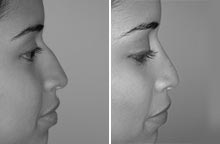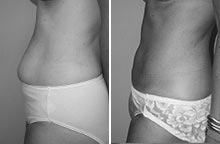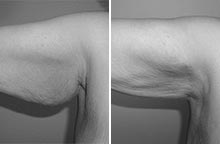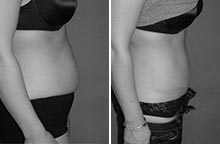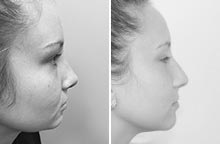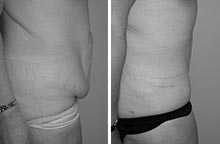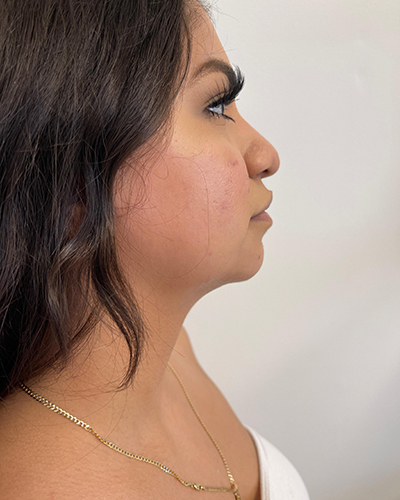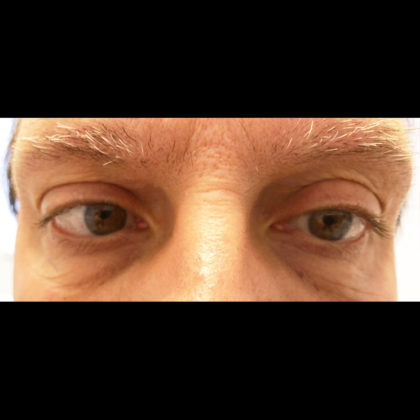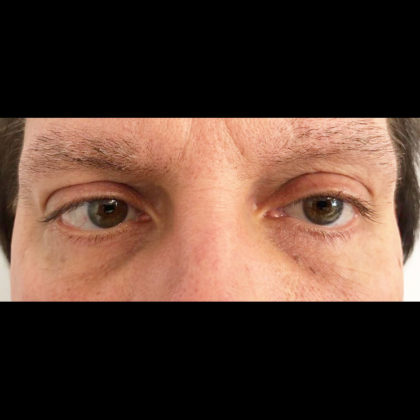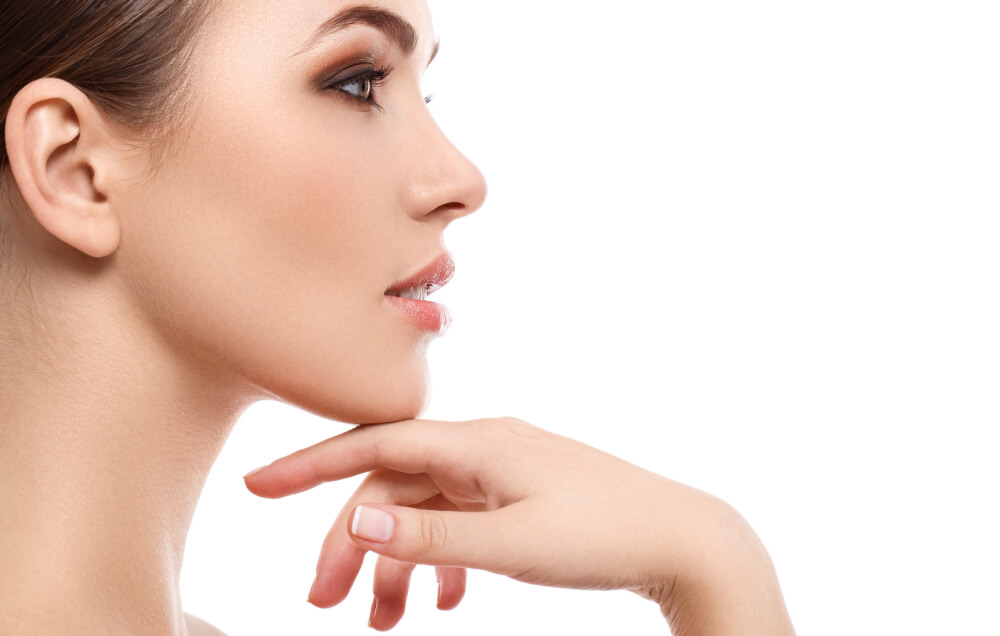Chemical peeling, or chemexfoliation, is one of the easiest, most effective ways to reduce the appearance of blemishes and wrinkles in the face. Of course, most patients realize that a chemical peel, naturally, involves varying degrees of skin peeling. However, there are rarely detailed accounts of the processes that happen after you leave the doctor’s office. What actually happens to your skin during recovery? And what can you do to ensure you get the best results?
David L. Abramson, MD is New Jersey and New York’s premier plastic surgeon. His med spa procedures are also the envy of many, as he strives to make as many aesthetic improvement options as possible available to his patients in Englewood, Franklin Lakes, and New York City.
To book a personal consultation to discuss your chemical peel options, call (201) 731-3134 or fill out our convenient form for further details.
Before and After Photos
Choosing a Chemical Peel
If you have never had a chemical peel before, it’s important to do your research. This is especially true if you opt for a deeper peel, which may involve anesthesia and a longer recovery period. There are so many peeling options to choose from, it can often feel daunting deciding which one is best for you. But knowing what you can expect from the chemical peel ahead of time means you’ll be well-prepared for your aftercare, and your results!
What Can a Chemical Peel Help Me With?
Getting a chemical peel is like a rejuvenating reset for your skin. But where do you begin when selecting the right one for you? Chemical peels can make a real difference to your facial appearance, especially if you have problem areas, such as:
- Acne Scars
- Breakout-Prone Skin
- Clogged Pores
- Dark Spots
- Dullness
- Fine Lines
- Hyperpigmentation
- Hypopigmentation
- Large Pores
- Sun Damage
- Textured Skin
- Wrinkle
Each peel varies slightly in chemical makeup, method, and aftercare requirements, and can be tailored to your specific needs. The first step is to choose the depth of your peel.
Peel Depth
Peeling can transform dull skin, acne-prone skin, and aging skin in need of rejuvenation. But it’s important to choose a peel that will address your issues if you have more serious skin concerns, and not get a peel that is too harsh for more superficial aesthetic needs.
- Superficial Peel – The superficial peel has gained popularity because it gives patients great results and has only mild side-effects. These peels only penetrate the epidermis, the topmost layer of the skin, so they’re great for superficial blemishes and skin brightening. (1)
Examples: glycolic acid peel, salicylic acid peel, mandelic acid peel.
- Medium-Depth Peel – A medium peel is for deeper skin issues, such as UV damage and fine lines. Most medium peels will penetrate past the epidermis to the next layer, the papillary dermis. In most cases, a medium peel requires the patient to take NSAID-based medication and undergo mild sedation. (1)
Examples: 50% TCA peel, 70% glycolic acid peel.
- Deep Peel – Deep peels reconfigure skin at the deepest level, the dermis. Some deep peels are so powerful, it is necessary to administer anesthesia beforehand. Peeling at this depth is very effective for more serious skin conditions such as deep scarring and deeper lines and wrinkles. (1)
Examples: ≥50% TCA peel, phenol peel.
Chemical Peels for Pigmented Skin
It is important to point out that deeper chemical peels are not the best treatment choice in all cases. Medium-depth peels and deep peels aren’t usually suitable for patients with darker skin types. This is because they can lead to permanent scarring and hyperpigmentation. In most cases, your doctor will recommend an alternative, such as a low percentage glycolic acid peel or salicylic acid peel.
Choosing the right person to conduct your chemical peel is important. Book a personal consultation with us to find out which type of peel is best for you by filling out our online contact form.
Peeling Science
The ingredients in chemical peels are caustic, meaning they are capable of causing damage to organic material.For this reason, the chemical processes that happen after any peeling treatment will involve a gradual sloughing of skin from the face during recovery.
When a chosen peel is placed on the treatment area, it begins to cause a controlled injury which will strip away dull, blemished skin to reveal fresher, softer skin beneath. Chemexfoliation is known to have antibacterial and anti-inflammatory effects. It can also limit sebum (oil) production and reduce the recurrence of acne breakouts. (2)
Recovery after a chemical peel will vary according to the type of peel you choose. Below are some examples of what you can expect from each of the three peel depths.
After a Superficial Peel
There may be a mild burning or tingling of the skin following a superficial peel. Skin can take up to two weeks to heal, despite the mild nature of the treatment. During this period, you will experience flaking and mild discomfort. Some patients complain about skin itchiness, which can be relieved with a gently-placed cool compress. Most patients experience very little discomfort, though there may be patches of discoloration.
After a Medium Peel
After a medium-depth peel, patients may experience a burning sensation which will subside once frosting occurs (only some peels). Frosting of the skin makes it appear tighter and paler. A neutralizing agent is then placed on the skin, causing an end to the burning sensation. Patients can also expect some swelling, short-term skin discoloration, and a recurrence of skin warmth. Where there is discomfort following a medium-depth peel, patients can take over-the-counter NSAID medications, and use cool packs to mitigate it. Where necessary, a patient may use a topical antibiotic such as Mupirocin. (1)
After a Deep Peel
Deep peeling requires extensive skill and experience on the part of the doctor performing it, and 100% commitment from the patient. With this method, patients can achieve effective treatment of severely photoaged skin, severe wrinkles and lines, and even premalignant lesions. (1)
However, all patients should know that a deep chemical peel carries significantly more risks, and a longer, more involved recovery period. Patients should therefore be well-prepared with this knowledge and understanding well before their treatment takes place.
Immediately after the peel, patients experience significant skin duskiness. There is usually no immediate discomfort as the patient’s comfort will be aided by anesthesia. In the days that follow, marked scabbing and crusting will take place, which will last for several days. As the skin has completely lost its protective barrier, it is very important to keep the area well-lubricated with a mild “bland” moisturizer. NSAID medications and cold compresses are recommended to manage post-procedure discomfort. The skin is also vulnerable to the outside environment, and to recurrence of herpes simplex virus, commonly known as cold sores. Because of this it will be necessary to take extra medications orally, and to apply Mupirocin antibiotic cream to lower the risk of infection. (1)
Find professional help for your facial skin concerns and rejuvenate your face with a chemical peel. Book your personal consultation with Dr. Abramson by calling (201) 731-3134.
Recovery Do’s & Don’ts
We will provide you with a list of aftercare instructions to ensure your recovery runs smoothly. It is very important to follow Dr. Abramson’s directions closely to ensure you get the best results.
For the best results:
- Cleanse your skin with a mild cleanser without exfoliating ingredients.
- Moisturize with a mild skin barrier-protecting moisturizer (e.g. CeraVe, Cetaphil).
- Wear a broad-spectrum sunscreen if this is unavoidable.
- Avoid sun exposure completely for the duration of your recovery.
- If sun exposure is necessary, use zinc oxide cream or a broad-spectrum sunscreen with care.
- Avoid very hot conditions (e.g. saunas, steam rooms, hot tubs).
- Avoid strenuous exercise or any activities that will involve excessive sweating.
Don’ts:
- Do not, under any circumstances, peel the skin manually or with any implement.
- Don’t pluck, tweeze, wax, or use any other hair removal methods in the treatment area.
- Don’t use retinol-based acne medications (e.g. Retin-A, isotretinoin).
- Don’t take photosensitizing antibiotics (e.g. doxycycline, tetracycline).
- Don’t undergo another skin resurfacing treatment such as microdermabrasion.
As always, we will be here to help you and give you aftercare advice after your chemical peel so feel free to contact us if you need any guidance during your recovery!
Cost of a Chemical Peel in Englewood, NJ
The cost of your chemical peel is highly dependent on the depth of the peel, the choice of chemexfoliation, and the additional resources needed for treatment. Get professional advice from Dr. Abramson and a full chemical peel consultation in Englewood, NJ, Franklin Lakes, NJ, or New York City by calling (201) 731-3134 or by filling out our contact form.
Stay up-to-date with the latest skin treatments by reading more posts on Dr. Abramson’s blog.
References
- Soleymani T, Lanoue J, Rahman Z. A Practical Approach to Chemical Peels: A Review of Fundamentals and Step-by-step Algorithmic Protocol for Treatment. The Journal of clinical and aesthetic dermatology. 2018;11(8):21-28. Accessed February 10, 2023. https://www.ncbi.nlm.nih.gov/pmc/articles/PMC6122508/#:~:text=Following%20treatment%20with%20medium%2Ddepth
- Chen X, Wang S, Yang M, Li L. Chemical peels for acne vulgaris: a systematic review of randomised controlled trials. BMJ Open. 2018;8(4):e019607. doi:https://doi.org/10.1136/bmjopen-2017-019607
